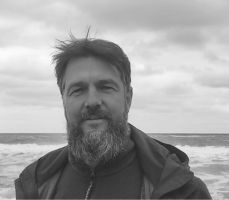
Dr. Daniel Herlemann

Seestrasse 15
D-18119 Rostock
Forschung
Salzgeschmack - Untersuchung der Bakteriengemeinschaft entlang des Salinitätsgradienten der Ostsee
Die Ostsee ist durch einen Salinitätsgradient geprägt, wobei 62% des Oberflächenwassers Brackwasser (Salinität 5-8) darstellt. Untersuchungen der Diversität von pelagischen Mikroorganismen in der Ostsee zeigten, dass sowohl rein marine als auch limnische Arten vertreten sind. Im Rahmen meiner aktuellen Arbeit untersuche ich die Sukzession von marinen zu limnischen Bakteriengemeinschaften entlang des Salzgradienten der Ostsee. In einen West-Ost-Gradient vom Skagerrak bis zur Bottensee wurden über 200 Standorte beprobt und mittels molekularbiologischer Methoden die Bakteriengemeinschaft bestimmt. Erste Ergebnisse diese Studie zeigen, dass sich die Bakteriengemeinschaft entlang des Salinitätsgradienten stark verändert und diese Veränderung vor allem auf Salinität zurückzuführen ist .
Mikrobiom-Wirts Interaktionen
Aktuelle Veröffentlichungen
Kivistik, Carmen; Tammert, Helen; Kisand, Veljo; Käiro, Kairi; Herlemann, Daniel PR Impact of disturbance and dietary shift on gastrointestinal bacterial community and its invertebrate host system,Molecular Ecology,32,23,6631-6643,2023,
Tammert, Helen; Kivistik, Carmen; Kisand, Veljo; Käiro, Kairi; Herlemann, Daniel PR Resistance of freshwater sediment bacterial communities to salinity disturbance and the implication for industrial salt discharge and climate change-based salinization,Frontiers in Microbiomes,2,,1232571,2023,Frontiers Media SA
Heller, Thomas; Herlemann, Daniel PR; Plieth, Anabel; Kröger, Jens‐Christian; Weber, Marc‐André; Reiner, Johannes; Jaster, Robert; Kreikemeyer, Bernd; Lamprecht, Georg; Schäffler, Holger; ,"Liver cirrhosis and antibiotic therapy but not TIPS application leads to a shift of the intestinal bacterial communities: A controlled, prospective study",Journal of Digestive Diseases,25,3,200-208,2024,Wiley Publishing Asia Pty Ltd Melbourne
Riedinger, David J; Fernández-Juárez, Victor; Delgado, Luis F; Sperlea, Theodor; Hassenrück, Christiane; Herlemann, Daniel PR; Pansch, Christian; Kataržytė, Marija; Bruck, Florian; Ahrens, Alwin; ,Control of Vibrio vulnificus proliferation in the Baltic Sea through eutrophication and algal bloom management,Communications Earth & Environment,5,1,246,2024,Nature Publishing Group UK London
Herlemann, Daniel PR; Tammert, Helen; Kivistik, Carmen; Käiro, Kairi; Kisand, Veljo; ,Distinct biogeographical patterns in snail gastrointestinal tract bacterial communities compared with sediment and water,MicrobiologyOpen,13,3,e13,2024,
Gyraitė, Greta; Kataržytė, Marija; Bučas, Martynas; Kalvaitienė, Greta; Kube, Sandra; Herlemann, Daniel PR; Pansch, Christian; Andersson, Anders F; Pitkanen, Tarja; Hokajärvi, Anna-Maria; ,"Epidemiological and environmental investigation of the ‘big four’Vibrio species, 1994 to 2021: a Baltic Sea retrospective study",Eurosurveillance,29,32,2400075,2024,European Centre for Disease Prevention and Control
Akademischer Werdegang
- seit 2023 Leibniz-Institut für Ostseeforschung Warnemünde
- seit 2018 Estonian University of Life Sciences
- 2009-2017 Leibniz-Institut für Ostseeforschung Warnemünde
- 2006-2009 Max-Planck-Institut für terrestrische Mikrobiologie, Marburg
- 2005 Helmholtz-Zentrum für Umweltforschung GmbH - UFZ, Leipzig
- 2003 Auslandssemester and der Universität Klaipeda, Litauen
- 2000-2005 Ernst-Moritz-Arndt-Universität Greifswald